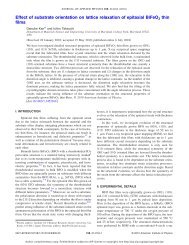Combinatorial and High-Throughput Screening of Materials ...
Combinatorial and High-Throughput Screening of Materials ...
Combinatorial and High-Throughput Screening of Materials ...
Create successful ePaper yourself
Turn your PDF publications into a flip-book with our unique Google optimized e-Paper software.
ACS <strong>Combinatorial</strong> Science<br />
REVIEW<br />
Figure 32. Schematic description <strong>of</strong> a C/HT workflow developed for the research <strong>and</strong> development <strong>of</strong> hybrid organic<br />
sol gel processing. 314<br />
inorganic coatings based on<br />
fabrication methods have been reported as summarized in<br />
Table 4. 316 344 Aspecific type <strong>of</strong> library layout depends on the<br />
required density <strong>of</strong> space to be explored, available library-fabrication<br />
capabilities, <strong>and</strong> capabilities <strong>of</strong> high-throughput characterization<br />
techniques. Upon array fabrication, the array is exposed to an<br />
environment <strong>of</strong> interest <strong>and</strong> steady-state or dynamic measurements<br />
are acquired to assess materials performance. Serial scanning<br />
mode <strong>of</strong> analysis (e.g., optical or impedance spectroscopies) is<br />
<strong>of</strong>ten performed to provide more detailed information about<br />
materials property over parallel analysis (e.g., imaging). When<br />
monitoring a dynamic process (e.g., response/recovery time,<br />
aging) <strong>of</strong> sensing materials arranged in an array with a scanning<br />
system, the maximum number <strong>of</strong> elements in sensor library that<br />
can be measured with the required temporal resolution can be<br />
limited by the data-acquisition ability <strong>of</strong> the scanning system. 338 In<br />
addition to measurements <strong>of</strong> materials performance parameters, it<br />
is important to characterize intrinsic materials properties. 40 <strong>Combinatorial</strong><br />
development <strong>of</strong> sensing materials can be categorized<br />
based on sensors that utilize various energy-transduction principles<br />
for their operation that involve radiant, mechanical, <strong>and</strong> electrical<br />
types <strong>of</strong> energy.<br />
3.4.1. <strong>Materials</strong> for Sensors Based on Radiant Energy Transduction.<br />
Sensors based on radiant energy transduction can be<br />
categorized on the basis <strong>of</strong> the five parameters that completely<br />
describe a lightwave, such as its amplitude, wavelength, phase,<br />
polarization state <strong>and</strong> time dependent waveform. The majority <strong>of</strong><br />
the developed sensing materials for these types <strong>of</strong> sensors rely on<br />
the formulated colorimetric <strong>and</strong> fluorescent materials <strong>and</strong> intrinsically<br />
conducting polymers.<br />
Optimizing formulated sensor materials is a cumbersome<br />
process because theoretical predictions are <strong>of</strong>ten limited by<br />
practical issues, such as poor solubility <strong>and</strong> compatibility <strong>of</strong><br />
formulation components. 319,345 347 These practical issues<br />
represent significant knowledge gaps that prevent a more<br />
efficient rational design <strong>of</strong> formulated sensor materials. Thus,<br />
combinatorial methods have been employed for the development<br />
<strong>of</strong> multicomponent formulated sensor materials for<br />
gaseous 319,329,348,349 <strong>and</strong> ionic 320,337,338,350,351 species.<br />
Applying polymers with an intrinsic conductivity also permits<br />
development <strong>of</strong> chemical <strong>and</strong> biological sensors based on radiant<br />
energy transduction. 352 356 A variety <strong>of</strong> conjugated organic<br />
monomers readily undergo polymerization <strong>and</strong> form linear<br />
polymers. For example, acetylene, p-phenylenevinylene, p-phenylene,<br />
pyrrole, thiophene, furane, <strong>and</strong> aniline form conducting<br />
polymers that are widely employed in sensors. 353,357 359 However,<br />
as prepared, conducting polymers lack selectivity <strong>and</strong> <strong>of</strong>ten<br />
are unstable. Thus, such polymers are chemically modified to<br />
reduce these undesirable effects. Modification methods include<br />
side-group substitution <strong>of</strong> heterocycles, doping <strong>of</strong> polymers,<br />
charge compensation upon polymer oxidation by incorporation<br />
<strong>of</strong> functionalized counterions, formation <strong>of</strong> organic inorganic<br />
hybrids, incorporation <strong>of</strong> various biomaterials (e.g., enzymes,<br />
antibodies, nucleic acids, cells), <strong>and</strong> others. 357,360,361 Variations<br />
in polymerization conditions (e.g., oxidation potential, oxidant,<br />
temperature, solvent, electrolyte concentration, monomer concentration,<br />
etc.) can be also employed to produce diverse<br />
polymeric materials from the same monomer because polymerization<br />
conditions affect sensor-related polymers properties<br />
610 dx.doi.org/10.1021/co200007w |ACS Comb. Sci. 2011, 13, 579–633












